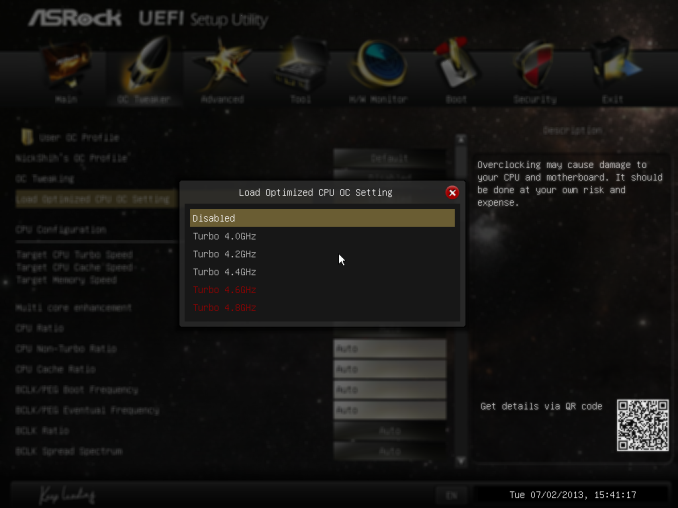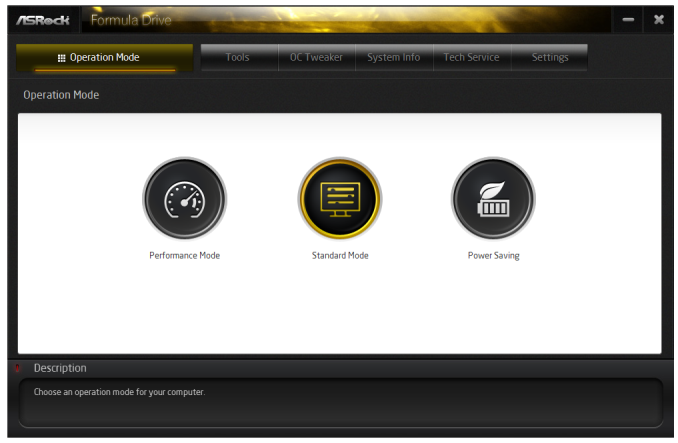ASRock Z87M OC Formula Review: mATX OC at $190
by Ian Cutress on August 14, 2013 10:00 AM EST- Posted in
- Motherboards
- ASRock
- Haswell
- Z87
ASRock Z87M OC Formula In The Box
As much as I hate to use the word, but the ‘swag’ inside a motherboard box is almost as important as the product itself. A company has two choices – either cost down to hit a price point, or give the customer what they want although charge them for it. There are plenty of cheap options manufacturers usually turn to (stickers, SATA cables that are bought in bulk, motherboard standoffs), but when placing money down on a themed product, a customer should not be left wanting for something from that special purchase. ASRock meets the customer half-way with the Z87M OC Formula. In the box we get:
Rear IO Shield
User Manual
Driver Disk
SLI Bridge
Four SATA Cables
Gelid GC-Extreme Thermal Paste
OC Formula Bag
Plastic Standoffs

The OC Formula special items are the bag, the standoffs, and the thermal paste. The thermal paste addition is, in my opinion, a bit mixed. Many of the enthusiasts who build PCs have a favorite paste that they use, and they have a lot of it – a 3ml tube can last 30+ applications, as I have only used 8ml since reviewing for AnandTech. By supplying users with a tube it means that they could benefit from lower temperatures than standard paste, but I can also imagine some users that are not used to building systems thinking they have to use the whole tube. This could be a bad thing.
ASRock Z87M OC Formula Overclocking
Experience with ASRock Z87M OC Formula
Much like the Z87 OC Formula, overclocking on ASRock motherboards has gotten a lot easier over the past few generations. Alongside the array of automatic options in the BIOS, the software options are growing and offer small improvements to almost all users. On the manual overclocking side, the input that ASRock gets from NickShih helps provide enthusiasts with the options they need to push the system, as well as more options that they can shake a stick at. With Nick providing pre-overclocked settings, and each option getting detail in the BIOS, enthusiasts are well equipped to take advantage.
Perhaps it is unsurprising then that our Z87M OC Formula overclocking results almost mirror those of the Z87 OC Formula/AC, even down to the voltages required in the BIOS to make the CPU stable at various CPU speeds.
Methodology:
Our standard overclocking methodology is as follows. We select the automatic overclock options and test for stability with PovRay and OCCT to simulate high-end workloads. These stability tests aim to catch any immediate causes for memory or CPU errors.
For manual overclocks, based on the information gathered from previous testing, starts off at a nominal voltage and CPU multiplier, and the multiplier is increased until the stability tests are failed. The CPU voltage is increased gradually until the stability tests are passed, and the process repeated until the motherboard reduces the multiplier automatically (due to safety protocol) or the CPU temperature reaches a stupidly high level (100ºC+). Our test bed is not in a case, which should push overclocks higher with fresher (cooler) air.
Automatic Overclock:
For automatic overclock options, users have a menu in the BIOS which gives presets between 4.0 GHz and 4.8 GHz in 200 MHz jumps:
At the 4.0 GHz settings, the system applied a 40x100 overclock with a +0.020 CPU voltage offset. This gave a PovRay score of 1649.72, a peak OCCT temperature of 64C, and 1.080 volts at load.
At the 4.2 GHz settings, the system applied a 42x100 overclock with 1.200 volts on the CPU. This gave a PovRay score of 1735.47, a peak OCCT temperature of 76C, and 1.216 volts at load.
At the 4.4 GHz settings, the system applied a 44x100 overclock with 1.300 volts on the CPU. This gave a PovRay score of 1823.90, a peak OCCT temperature of 90C, and 1.304 volts at load.
At the 4.6 GHz settings, the system applied a 46x100 overclock with 1.320 volts on the CPU. This gave a PovRay score of 1900.28, a peak OCCT temperature of 95C, and 1.328 volts at load.
At the 4.8 GHz settings, the system applied a 48x100 overclock with 1.400 volts on the CPU. This gave a PovRay score of 1844.54, indicating CPU overheating and throttling. The OCCT temperature test failed, and the CPU reported 1.408 volts at load.
The user also has options in the OS using the Formula Drive software:
In standard mode, the system performed at stock, giving a PovRay score of 1612.8, a peak OCCT temperature of 70C, and a load voltage of 1.160 volts.
In power saving mode, the system stays at idle until it experiences a sustained load. At this point, it will slowly ramp up the CPU speed, taking 8-10 seconds to reach a full 3.9 GHz. With this setting, we achieved a PovRay score of 1507.14, a peak OCCT temperature of 68C, and load voltage of 1.160 volts.
In Performance mode, the system applies 39x on every core at both idle and at load. This gives a PovRay score of 1603.11, a peak OCCT temperature of 72C and a load voltage of 1.160 volts.
Using the Auto Tuning function in Performance Mode, the system starts at 3.0 GHz and stress tests the system to find a stable clock speed. Our system stopped at 4.3 GHz, where it achieved a PovRay score of 1770.98, a peak OCCT temperature of 78C and a load voltage of 1.288 volts.
Manual Overclock:
Manual overclocking was performed in the BIOS, starting at 1.000 volts and 40x100, raising the CPU voltage when unstable and the CPU multiplier when stability is found. For these settings Load Line Calibration was set to Level 2 and VRIN voltage was set to 1.650 volts.













25 Comments
View All Comments
Pessimism - Wednesday, August 14, 2013 - link
Who overclocks anymore? Better off to just save your money and buy the next CPU up IMO.Horza - Wednesday, August 14, 2013 - link
So if I buy a 4770k and overclock it to 4.5hgz (kind of the point with the K series) what's your advice?Overclocking is an easy way to get some free performance and can be a bit of fun at the same time.
Pessimism - Wednesday, August 14, 2013 - link
Since you're already at the top end for desktop parts, my advice would depend on what task you perform that saturated the 4770K at stock speeds.RealiBrad - Wednesday, August 14, 2013 - link
So if I'm a gamer, its better for me to buy an I7 over an I5, even though I can get an I5 and OC it past the base performance of any I7.Why?
Pessimism - Wednesday, August 14, 2013 - link
You will spend more on the rest of the computer to do it than if you had bought the i7 in the first place. You will also spend more on electricity to power your PC. Yes you will gain a little CPU capacity over a stock i7, I can't deny that. However you haven't provided any example of an everyday gaming or computing scenario that saturates an i7 and justifies all the extra expense, energy consumption and hassle. Don't get me wrong, I was clocking the snot out of a 2500 Barton back in the day like everyone else, I just think the cost/benefit ratio isn't there anymore when you look at how far hardware is past software right now.karasaj - Wednesday, August 14, 2013 - link
Starcraft II. I can bring my 4.6ghz 4670k to its knees in real world scenarios if I want too. That wasn't hard :Pkarasaj - Wednesday, August 14, 2013 - link
Real world scenarios being team games and intense 1v1's.owan - Wednesday, August 14, 2013 - link
"All the extra expense"... how much do you think it costs? With an unlocked multiplier on the CPU's, its quite easy to overclock and doesn't incur much added expense. Any halfway decent motherboard that has the features you want on it is going to be fully capable of overclocking quite a bit anyway. The electricity difference is going to still be there, but is probably fairly small.. Maybe 20-30W ? With TDP's on the Intel chips these days, it really doesn't take a big cooler to cool them, even if overclocked. A CM Hyper 212+ can be bought for something like $20 and does the job really well. Lots of people would be buying an HSF capable of handling the additional heat anyway. You could easily build a rig capable of overclocking for less than it would cost to jump to a high-end i7 and get equal or better performance.RealiBrad - Wednesday, August 14, 2013 - link
So if I'm building a new system, and the game I'm likely to play will have a cpu bottleneck with an i5-4670, its cheaper for me to spend more on upgrading to a locked i7-4770 for $90 more and get a few frames increase at best? Why would it not be better to take that same $90 and get a i5-4670k and a mobo that can adjust the multiplier? If an i5 is bottlenecked then getting any locked i7 will do nothing. Its far better to get an unlocked i5 and OC it to reduce the bottle neck. yes, the mobo will cost a little more, but the jump from an i5 to an i7 is still more expensive than getting a i5 k and mobo.IanCutress - Wednesday, August 14, 2013 - link
It depends what you do. If you overclock and get another 25% performance, that enables you to complete 5 tasks in the same time as 4. If the reward for doing that task is more than the cost of the electricity, then it's a no brainer. This is particularly relevant in the financial industries, where every millisecond counts, or for careers that are throughput limited.That's just for workloads - gamers are often not worried about the cost of electricity when it comes to pure performance, and overclocking to increase single core performance, particularly in games like Civilization V that respond well to overclocking (http://www.anandtech.com/show/6985/choosing-a-gami... result in a rise of FPS.
There is also the aspect of competitive overclockers, who see it as a challenge to out-overclock their competitors. As mentioned in the review, this is one of the target groups for OC-oriented motherboards, and the motherboard needs to have features to appeal to this crowd.
Just because you do not overclock anymore does not mean that the activity is dead/no longer useful. It is alive and kicking - the amount of pre-overclocked systems on sale today is just one prong of this.
Ian